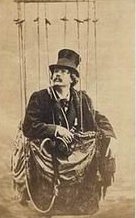Carte de visite: Difference between revisions
No edit summary |
m →The American Civil War: wikified JW Booth |
||
| Line 12: | Line 12: | ||
<gallery> |
<gallery> |
||
Image:Abraham Lincoln half length seated, April 10, 1865.jpg|Carte de visite of Lincoln; February 5th, 1865, by [[Alexander Gardner (photographer)|Gardner]] |
Image:Abraham Lincoln half length seated, April 10, 1865.jpg|Carte de visite of Lincoln; February 5th, 1865, by [[Alexander Gardner (photographer)|Gardner]] |
||
Image:jwbooth.jpeg|Carte de visite of Booth; around 1863, by [[Alexander Gardner (photographer)|Gardner]] |
Image:jwbooth.jpeg|Carte de visite of [[John Wilkes Booth|Booth]]; around 1863, by [[Alexander Gardner (photographer)|Gardner]] |
||
</gallery> |
</gallery> |
||
Revision as of 13:39, 2 March 2009

The carte de visite or CDV (also carte-de-visite) was a type of small photograph which was patented in Paris, France by photographer André Adolphe Eugène Disdéri in 1854.[1] It was usually made of an albumen print, which was a thin paper photograph mounted on a thicker paper card. The size of a carte de visite is 2⅛ × 3½ inches mounted on a card sized 2½ × 4 inches. It was made popular in 1859 in Europe, and from 1860 in the United States. The new invention was so popular it was known as "cardomania"[2] and eventually spread throughout the world. In 1854, Disdéri had also patented a method of taking eight separate negatives on a single plate.
Each photograph was the size of a visiting card, and such photograph cards became enormously popular and were traded among friends and visitors. The immense popularity of these card photographs led to the publication and collection of photographs of prominent persons. "Cardomania" spread throughout Europe and then quickly to America. Albums for the collection and display of cards became a common fixture in Victorian parlors.
By the early 1870s, cartes de visite were supplanted by "cabinet cards," which were also usually albumen prints, but larger, mounted on cardboard backs measuring 4½ by 6½ inches. Cabinet cards remained popular into the early twentieth century, when Kodak introduced the Brownie camera and home snapshot photography became a mass phenomenon.
The American Civil War
The carte de visite photograph proved to be a very popular item during the American Civil War. Soldiers, friends and family members would have a means of inexpensively obtaining photographs and sending them to loved ones in small envelopes. Photographs of Abraham Lincoln, Ulysses S. Grant, and other celebrities of the era became an instant hit with the public. People were not only buying photographs of themselves, but also photographs of celebrities.
-
Carte de visite of Lincoln; February 5th, 1865, by Gardner
Gallery
-
Two examples of carte de visite photographs taken during the American Civil War. Each soldier shown here served with the 77th Illinois Volunteer Infantry.
-
Carte de visite of Sojourner Truth. She sold these to raise money (see inscription)
-
The only known photograph of Mary Seacole, taken for a carte de visite by Maull & Company in London in c.1873.
-
Carte de visite of Sim D. Kehoe, who brought Indian clubs to the United States from England
References
External links
- http://www.mathewbrady.com
- Portraits of Scientists: Increase Lapham's Cartes-de-visite Collection Collected by pioneering Wisconsin antiquarian Increase Lapham between 1862-75, this album of carte-de-visite photographic portraits depicts many notable 19th-century scientists from America and Europe. Available on Wisconsin Historical Images, the Wisconsin Historical Society's online image database.
- University of Washington Libraries Digital Collections – 19th Century Actors Photographs Cartes-de-visite studio portraits of entertainers, actors, singers, comedians and theater managers who were involved with or performed on the American stage in the mid- to late 1800s.
- Gettysburg College Nineteenth Century Notables Digital Collection
- Duke University Libraries Digital Collections -- William Emerson Strong Photograph Album 200 cartes-de-visite depicting officers in the Confederate Army and Navy, officials in the Confederate government, famous Confederate wives, and other notable figures of the Confederacy. Also included are 64 photographs attributed to Matthew Brady.






